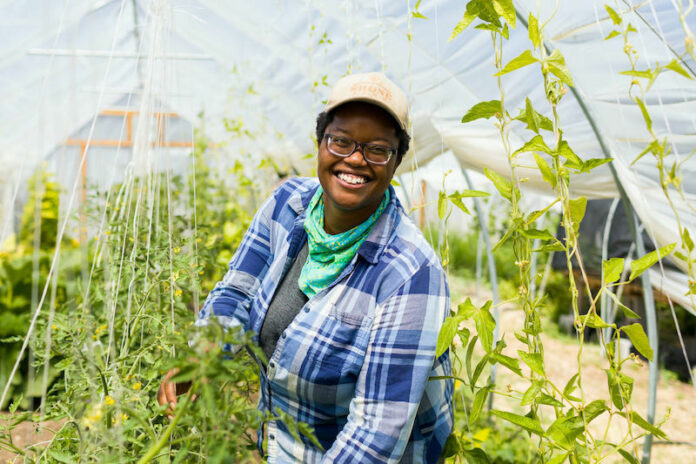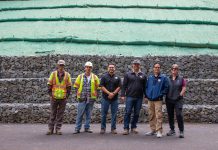
In under a week, Kiley Clark has raised over $75,000 to put toward starting a Black-owned, regenerative farm
Due to low profit margins and high start-up costs, starting a farm can be difficult. The need for a significant expanse of land, especially locally, makes the journey to starting a farm even more challenging. That’s one of the reasons Kiley Clark started a farm fundraising campaign. In a week, Clark’s gofundme campaign surpassed its original goal of raising $50,000 to help Clark start her own Black-led, regenerative farm. As of press time, Clark’s campaign had raised $76,557.
Clark, who works at Radical Family Farm in Sebastopol, said that the funding campaign has gone better than she could’ve imagined.
“I’m surprised and blown away by how well it’s doing,” she said. “I was actually making a 60-day plan, but I wasn’t expecting it to go this fast at all.”
When Sonoma West interviewed her on July 1, just three days after the gofundme was posted, the campaign was at around $45,000 and had grown by hundreds of dollars in the span of a few minutes. Now, the money raised will help make Clark’s dream a reality.
“I was kind of hesitant about it (starting a gofundme), but I started it after some insisting and some friendly pressure from folks I know. I think folks are thinking that there’s enough support out there if I reach the right people that I could actually make this happen,” she said.
The challenge for Black agriculture
According to the most recent statistics from the United States Department of Agriculture, in 2017, Black agriculture producers accounted for 1.4% of the country’s total 3.4 million people who produce the country’s agriculture.
“With Black farm ownership at only 2% in the United States and with threats to agricultural systems and widespread food insecurity, now is the time to set forth on a dream I have been cultivating for the last decade,” Clark wrote in her gofundme fundraiser introduction. “I am currently searching for land to start my own farm while writing and researching the challenges facing new and aspiring farmers, especially Black farmers.”
Learning on the road
The statistic on Black farm ownership was amplified for Clark when she took a trip in 2019, where she visited over 30 farms in five western states and helped highlight the experiences of farmers she stayed with. The trip re-instilled in Clark her desire to own her own farm.
“I think coming back from the trip, I felt like I had a lot of work to do or figuring out, to get to a place where I would be able to have my own farm,” she said. “It’s a challenging thing to have a farm, because it requires so much upstart and capital to get one going. Without generational wealth, like having land someone leaves you or money for a down payment that somebody gives you, it’s hard to start farming before an old age.”
The trip also helped shape her vision of what she wants to see in her own farm.
“I got to meet all these really great people and learn about how all these other people farm, which is really important,” she said. “I think that’s the thing that a lot of us forget is if you go to a farm you’re most likely going to a place where people live, where their families live.”
The funds raised in the last week will hopefully help bridge the financing gap that keeps young people and people of color out of the market. Now, Clark is looking for land — likely outside of Sonoma County, due to the cost. She said that she’s looking at going somewhere on the west coast, either staying in California or getting property in either Oregon or Washington. Another silver lining to the fundraising campaign has been people coming forward with suggestions of land that’s available locally.
Clark said that while she’s open to moving somewhere else on the west coast, she would like to stay in California, since the weather lends itself to farming and since she’s lived in California for most of her life.
“For me, I’ve just been trying to figure out where I fit in. I don’t feel like there’s any like — I don’t fit these A, B, C, D characteristics — I think we need a bigger variety of people and backgrounds and locations of farming,” she said.
What is regenerative farming?
In Clark’s words, building a regenerative farm means creating a farm that’s as natural as possible, while still being profitable.
“I compare regenerative farming to sustainable agriculture. If you’re thinking about sustaining something, that means to keep it at the level that it is now. Regenerative, to me, is more restorative — making things better than the way you found them. For me, regenerative agriculture means using more natural techniques, older techniques, things that might have been considered Indigenous techniques of farming. I think what would be called permaculture now, having more of a natural setting in a way.”
According to the gofundme page, the money raised will go toward a down payment on a 3- to 10-acre property, start-up costs for farm equipment and farm infrastructure like irrigation.
“This is such a wonderful problem to have, is to figure out where I want to go,” Clark said. “It’s definitely taken some stress off of me. I feel like, with the gofundme, I have more options to purchase, to buy a place and to have start-up costs right there is such a blessing. I’m so excited and nervous and hopeful and ready.”








